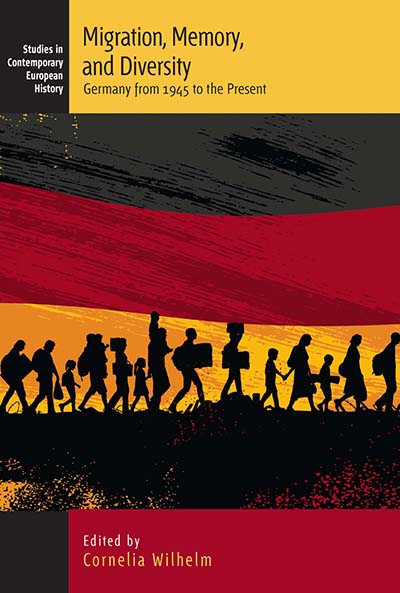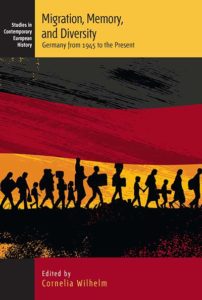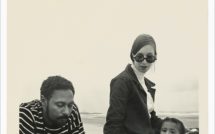
Migration, Memory, and Diversity: Germany from 1945 to the Present edited by Cornelia Wilhelm

This is part of our special feature Governing the Migration Crisis.
Reading the headlines in the summer of 2015, one might think that migration was a wholly new challenge for Europeans and specifically for Germans. Many of the contributors to this volume are explicit about their desire to intervene in this political culture of historical amnesia and in doing so contribute to what editor Cornelia Wilhelm identifies as “a new, more inclusive understanding of Germanness and of Germany’s role as a destination for immigrants” (5). Although the essays range across a wide variety of topics, there are consistent attempts to place developments in West Germany in a comparative and European framework.
The first section ranges widely across post-1945 migrant groups. Martin Schulze Wessel describes changing interpretations of the expulsion of ethnic Germans, raising questions about the possibility for a shared memory of expulsions between Germany and the “expeller states,” including Poland, the Czech Republic, and Slovakia. He makes a strong argument for careful historicization, concluding that “the more precise the commemoration of expulsions becomes… the higher the chances are for a common European memory of World War II” (26). Anna Holian contributes a thoughtful essay on the history of Displaced Persons in the Federal Republic of Germany, making a strong case for the integration of DP history into migration history. Asiye Kaya’s essay on “the politics of labeling” compares “integration” policies towards different immigrant groups, highlighting the way that state policies and attitudes towards groups effect migrant inclusion in the polity.
As the final essay in this section, Patrice Poutrus’ “Refugee Reports” will prove especially useful to readers looking to better understand the current “refugee crisis.” He investigates the historical contrast between Germany’s seemingly liberal guarantee to asylum and the way that the guarantee has been applied in practice. His case study of the 1956 Hungarian Revolution shows that the summer of 2015 was not the first time that German civil society welcomed refugees. Nevertheless, refugee admissions have also repeatedly provoked strong negative reactions, and West Germany “never ceased to fear that the admission of refugees would disturb its internal stability and endanger the newly won credibility that it enjoyed” (93). This dynamic of acceptance and rejection has continued into the present, as the Wilkommenskultur of summer 2015 has been overshadowed by heated debates about whether Germany should cap refugee admissions or ban family reunion for recognized refugees.
The second section is dedicated to commemoration, with essays about the representation of migration in history textbooks, history museums, and archival collections. Simone Lässig finds that although migration was marginal in textbooks for a long period, textbooks have followed academic scholarship and increasingly included positive portrayals of migration since the 1980s. Dietmar Osses and Katarzyna Nogueira compare the way that museums treat migration in Germany with France, where there has been a National Museum of Migration since 2007. Although Germany does not plan a similar national museum, Osses and Nogueira point to “the boom of migration exhibitions on all levels” and “migration mainstreaming in museums” (168) as positive developments. Would-be curators and graduate students will find Klaus Lankheit’s contribution on “Archival Collections and the Study of Migration” invaluable, as he traces both extant collections and the ongoing work of archivists to preserve the history of migration, including projects such as the oral history project at the Nürnberg Municipal Archives and the collection, research, and exhibition work of DOMID [Documentation Center and Museum of Migration in Germany] in Cologne.
The final essay in this section, Rita Chin’s “Thinking Difference in Postwar Germany: Some Epistemological Obstacles around ‘Race,’” initially seems like an uneasy fit in this section, but it identifies an important obstacle to representing the past: the deliberate exclusion of “race” and “racism” as acceptable categories within public discourse. Chin argues that “the refusal of many scholars and policymakers to take the key role of race in the Federal Republic seriously has come at a high cost.” Chin suggests that scholarship on “racial formation” and “racialization” that investigates race not as a biological reality but as “a socially constructed, historically contingent category” can serve as a model for scholars seeking to understand “the myriad ways in which assumptions of essential difference naturalize… legal and social exclusion” (220-221).
The final section zeroes in on developments since German unification. Dietmar Schirmer argues that unification ended the “provisional” status of the FRG and allowed for rapid change around citizenship law and conceptions of the nation. Kathrin Bower creatively considers the encounter between East and West Germans as another way in which Germans have had to grapple with diversity since 1989. Karen Körber contributes an illuminating essay on Jewish quota refugees since 1989, showing how a policy inspired by an ideal of symbolic atonement has clashed with the reality of immigrants with their own understandings of what it means to be Jewish in Germany. Finally, Annette Seidel-Arpaci’s essay argues that Holocaust education tends to understand immigrants erroneously as a group without previous relationships to the events of the Second World War. She highlights the way that blaming Muslim immigrants for “imported anti-Semitism” serves to occlude the ways in which anti-Semitism continues in Germany.
The wide variety of topics considered here represents the anthology’s primary strength but also arguably its weakness. The decision to bring multiple migrant groups into the same volume is a useful counterbalance to what Holian correctly calls “the fragmentation that plagues migration studies” (47), but because relatively few essays compare migrant groups, the overall effect is one of juxtaposition rather than comparison. Particularly in the context of memory, it would also have been useful to explore ways to narrate post-1945 migrations within the context of much longer patterns of migration in German history. Might it be fruitful to compare the treatment of asylum seekers since 1945 with the treatment of Russians in 1917 or even the French in the German lands after 1789? In my own work, I’ve noticed that officials in the Federal Republic frequently understood Turkish labor migration through analogies to Polish labor migration in the interwar period—can such comparisons help to create a public culture that treats migration as a normal part of German history?
The afterword, by Holger Kolb, is a shortened and translated version of a piece previously published in the 2016 Handbuch Staat und Migration in Deutschland seit dem 17. Jahrhundert edited by Jochen Oltmer. Kolb analyzes recent changes in German migration and integration policy, carrying forward one of the book’s implicit arguments about fundamental change since 1990 to argue that unified Germany has become more “European” in its policies towards immigration. Although it is valuable to have an English translation of this piece, the collection suffers from the lack of an epilogue to tie the contributions together thematically.
What might such an epilogue look like? I was struck by the fact that many of the essays explicitly considered the question of “whether problems with diversity and memory are uniquely ‘German’” (5). This very manner of posing the question reveals the underlying assumption that Germany’s relationship to migration is peculiar—the lingering “stereotype of xenophobic Germany” (xi) that Konrad Jarausch mentions in the preface—and that it represents a deviation from the norm.
But if we’ve learned one thing from the past two years, it is that no country—including the United States, often taken as the implicitly standard “migration country” in comparative studies—can boast of a “normal” or an uncomplicatedly positive attitude to migration. The welcome contextualization in so many of these essays makes it clear that Germans have been just as hostile to immigrants—but also just as welcoming—as many of their neighbors. Indeed, the afterword by Kolb makes it clear that “normalization” and “Europeanization” are not synonymous with “liberalization.” The 1993 restriction of the constitutional guarantee to asylum was an effect of German “Europeanization.” Since 2000, policy harmonization around family reunification and “integration” of migrants who come from outside of Europe have tended to lead to more restrictive policies. Throughout the book, we find support for Kaya’s argument that a “European identity based on the othering/foreignization and stigmatization of the Muslim and Roma minorities is not only a German phenomenon” (75).
This is where Chin’s essay points one possible way forward for migration studies: many scholars of migration and “difference” in Europe—not just those in Germany—have rejected “race” as an analytic category after National Socialism, but the disappearance of explicit references to “race” in the public sphere does not mean that beliefs about essential difference have disappeared. Without a language of racialization, we cannot understand the Alternative für Deutschland election poster featuring the pregnant belly of a white woman and the caption “New Germans? We’ll Make Them Ourselves!” We also cannot understand the way that Frontex and its partners force suspected migrants to produce documents in North Africa, policing Europe’s borders at a remove of thousands of kilometers. Sustained attention to the way that assumptions about “European identity” are reproduced will help us to understand not just German, but also European attitudes towards immigration.
Reviewed by Lauren Stokes, Northwestern University
Migration, Memory, and Diversity: Germany from 1945 to the Present
Edited by Cornelia Wilhelm
Publisher: Berghahn
Hardcover / 336 pages / 2016
ISBN: 978-1-78533-327-9
Published on October 2, 2017




